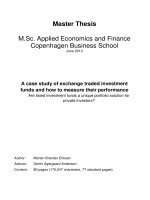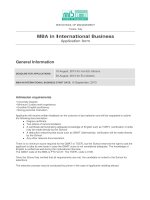Exporting, importing, and countertrade (INTERNATIONAL BUSINESS)
Bạn đang xem bản rút gọn của tài liệu. Xem và tải ngay bản đầy đủ của tài liệu tại đây (191.91 KB, 37 trang )
Chapter 13
Exporting, Importing,
and Countertrade
Introduction
Question: What type of firm benefits from
exporting?
Both large and small firms can benefit from
exporting
The volume of export activity in the world
economy is increasing as exporting has become
easier thanks to
the decline in trade barriers under the WTO
regional economic agreements such as the
European Union and the North American
Free Trade Agreement
13-2
Introduction
Question: What do firms that want to export
need to do?
Firms wishing to export must
identify export opportunities
avoid a host of unanticipated problems
associated with doing business in a foreign
market
become familiar with the mechanics of export
and import financing
learn where to get financing and export credit
insurance
learn how to deal with foreign exchange risk
13-3
The Promise and Pitfalls
of Exporting
Question: What are the benefits of exporting?
The benefits from exporting can be great--the
rest of the world is a much larger market than
the domestic market
Larger firms may be proactive in seeking out
new export opportunities, but many smaller
firms take a reactive approach to exporting
Many novice exporters have run into significant
problems when first trying to do business
abroad, souring them on following up on
subsequent opportunities
13-4
The Promise and Pitfalls
of Exporting
Question: What are the pitfalls facing exporters?
Common pitfalls for exporters include
poor market analysis
poor understanding of competitive conditions
a lack of customization for local markets, poor
distribution arrangements, bad promotional
campaigns
a general underestimation of the differences
and expertise required for foreign market
penetration
difficulty dealing with the tremendous paperwork
and formalities involved
13-5
Improving Export Performance
Question: How can exporters improve
their performance?
To improve their success, exporters
should
acquire more knowledge of foreign
market opportunities
consider using an export management
company
adopt a successful export strategy
13-6
An International Comparison
Many firms fail to consider export
opportunities simply because they lack
knowledge of the opportunities available
Both Germany and Japan have
developed extensive institutional
structures or promoting exports
Japanese exporters can also take
advantage of the knowledge and
contacts of sogo shosha, the country’s
great trading houses
13-7
Information Sources
The U.S. Department of Commerce is
the most comprehensive source of
information for U.S. firms
Firms can get a “best prospects” list of
potential foreign distributors
Firms can also participate in trade fairs
or get assistance from the Small
Business Administration
13-8
Utilizing Export Management
Companies
Question: What assistance can exporters get
from export management companies?
Export management companies are export
specialists that act as the export marketing
department or international department for client
firms
EMCs
1. start exporting operations for a firm with the
understanding that the firm will take over
operations after they are well established
2. start services with the understanding that the
EMC will have continuing responsibility for
selling the firm’s products
13-9
Export Strategy
Question: What steps should exporters take to
increase their chances of success?
Exporters
can hire an EMC to help identify
opportunities and navigate paperwork and
regulations
start by focusing initially on just one or a few
markets
enter a foreign market on a fairly small scale
in order to reduce the costs of any
subsequent failures
13-10
Export Strategy
Exporters should also
recognize the time and managerial
commitment involved in building
export sales
devote attention to building strong and
enduring relationships with local
distributors and customers
hire local personnel to help the firm
establish itself in a foreign market
keep the option of local production
13-11
Export and Import Financing
Question: How can firms deal with the
lack of trust that exists in export
transactions?
Various mechanisms for financing
exports and imports have evolved over
the centuries in response to lack of trust
that exists in export transactions
13-12
Lack of Trust
Exporters and importers have to trust someone
who may be very difficult to track down if they
default on an obligation
Each party has a different set of preferences
regarding the configuration of the transaction
Exporters prefer to be paid in advance, while
importers prefer to pay after shipment arrives
Problems arising from the lack of trust can be
solved by using a third party who is trusted by
both - normally a reputable bank
13-13
Letter of Credit
A letter of credit is issued by a bank at
the request of an importer and states the
bank will pay a specified sum of money
to a beneficiary, normally the exporter, on
presentation of particular, specified
documents
This system is attractive because both
parties are likely to trust a reputable
bank even if they do not trust each other
13-14
Draft
Question: How is payment actually made in an
export transaction?
Most export transactions involve a draft, also
called a bill of exchange
A draft is an order written by an exporter
instructing an importer, or an importer's agent,
to pay a specified amount of money at a
specified time
A sight draft is payable on presentation to the
drawee while a time draft allows for a delay in
payment - normally 30, 60, 90, or 120 days
13-15
Bill of Lading
The bill of lading is issued to the exporter
by the common carrier transporting the
merchandise
It serves three purposes
it is a receipt
it is a contract
it is a document of title
13-16
Classroom Performance System
An order written by an exporter instructing
an importer to pay a specified amount of
money at a specified time is
a) A letter of credit
b) A draft
c) A bill of lading
d) A confirmed letter of credit
13-17
A Typical International Transaction
13-18
Classroom Performance System
A bill of lading serves all of the following
purposes except
a) It is a receipt
b) It is a contract
c) It is a document of title
d) It is a form of payment
13-19
Export Assistance
Question: Where can exporters get financing
help?
U.S. exporters can draw on two forms of
government-backed assistance to help their
export programs
1. they can get financing aid from the ExportImport Bank
2. they can get export credit insurance from
the Foreign Credit Insurance Association
13-20
Export-Import Bank
1. The Export Import Bank
The Export-Import Bank (Eximbank) is
an independent agency of the U.S.
government
Its mission is to provide financing aid
that will facilitate exports, imports, and
the exchange of commodities between
the U.S. and other countries
13-21
Export Credit Insurance
2. Export Credit Insurance
In the U.S., export credit insurance is
provided by the Foreign Credit Insurance
Association (FICA)
FICA provides coverage against
commercial risks and political risks
13-22
Countertrade
Question: What alternatives do exporters
have when conventional methods of
payment are not an option?
Exporters can use countertrade when
conventional means of payment are
difficult, costly, or nonexistent
Countertrade refers to a range of barterlike agreements that facilitate the trade of
goods and services for other goods and
services when they cannot be traded for
money
13-23
The Incidence of Countertrade
In the 1960s the Soviet Union and the
Communist states of Eastern Europe, whose
currencies were generally nonconvertible,
turned to countertrade to purchase imports
Many developing nations that lacked the foreign
exchange reserves required to purchase
necessary imports turned to countertrade during
the 1980s
There was a notable increase in the volume
of countertrade after the Asian financial crisis
of 1997
13-24
Types of Countertrade
There are five types of countertrade
1. barter
2. counterpurchase
3. offset
4. switch trading
5. compensation or buyback
13-25









